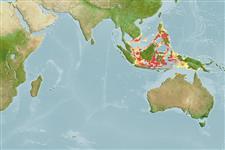Classification / Names
आम नाम | उपशब्द | Catalog of Fishes(वर्ग, प्रजाति) | ITIS | CoL | WoRMS | Cloffa
>
Gobiiformes (Gobies) >
Gobiidae (Gobies) > Gobiinae
Etymology: nobilis: Named for its common name, Majestic shrimpgoby, Latin 'nobilis' meaning noble, English translation of which is a synonym of 'majestic'..
More on authors: Allen & Randall.
Environment: milieu / climate zone / depth range / distribution range
पारिस्थितिकी
समुद्री ड़िमरसल; गहराई सीमा 5 - 30 m (Ref. 90102). Tropical
Western Pacific: Philippines and Indonesia.
आकार / वज़न / Age
Maturity: Lm ? range ? - ? cm
Max length : 7.0 cm TL पुल्लिंग / अलिंग; (Ref. 90102)
पृष्ठीय रीढ़ (सम्पूर्ण): 7; पृष्ठीय सौफट रेज़ (सम्पूर्ण): 16; गुदा कांटा 1; ऐनल सौफट रेज़: 17. This species is distinguished by the following set of characters: D VI-I, 16; A I, 17; pectoral rays 17-18; scales in longitudinal series 63-68; without scales on head, nape, or prepectoral area; ctenoid scales posteriorly, cycloid anterior to base of sixth dorsal spine; males with elongate body (depth 6.9 in SL), females stouter (depth 5.2-5.3 in SL); gill opening extending forward nearly to a vertical at posterior edge of orbit; dorsal spines progressively longer to third (at least 3.65-4.0 in SL); caudal fin long and pointed (1.9-2.2 in SL); pectoral fins in male reaching to above anal fin origin, or to anus in females, 4.2-4.4 in SL; pelvic fins do not reach base of first anal soft ray (4.1 in SL); distinct colour pattern features of males include a mid-dorsal, neon blue stripe on head, irregular orange spots, bars, and bands on cheek, operculum, and adjacent pectoral fin base, a pair of broad brownish-orange stripes on dorsal half of body edged with pair of narrower stripe of pale blue (clearly evident anteriorly, but becoming diffuse or forming clusters of scattered blue spot/flecks on posterior half ), a dark brown to subtle light brown orange spot (sometimes greatly reduced) on first dorsal fin between second and fifth spines, a dark submarginal stripe on posterior two-thirds of anal fin, and small orange spots covering pelvic fin; females similar, but markings on side less vivid and with distinctive brownish to bright orange yellow spot narrowing distally to middle of fin (Ref. 75784).
Inhabits silty-sand bottoms in sheltered waters, singly or in male/female pairs. Shares the same burrows with unidentified species of Alpheus, a snapping shrimp (Ref. 75784).
Life cycle and mating behavior
परिपक्व अवधि | पुनरुत्पत्ति | मछलीऔ का अंडे देना | अंडे | Fecundity | लार्वा
Allen, G.R. and J.E. Randall, 2006. Vanderhorstia nobilis, a new species of shrimpgoby for Indonesia and the Philippines. aqua, J. Ichthyol. Aquat. Biol. 12(1):39-44. (Ref. 75784)
IUCN Red List Status (Ref. 130435)
Threat to humans
Harmless
Human uses
अधिक जानकारी
आम नामउपशब्दचपायचयपरभक्षीईकोटोकसीकोलौजीपुनरुत्पत्तिपरिपक्व अवधिमछलीऔ का अंडे देनाSpawning aggregationFecundityअंडेEgg development
संदर्भजलीयकृषिजलीयकृषि रूपरेखाखींचआनुवंशिकीElectrophoresesहैरेटिबिलटीबीमारीप्रक्रमणNutrientsMass conversion
सहयोगीयोतस्वीरेStamps, Coins Misc.ध्वनिसिगुयटिरारफ्तारतैरने के प्रकारगिल क्षेत्रOtolithsदिमागदृष्टि
साधन
Special reports
Download XML
इंटरनेट स्रोत
Estimates based on models
Preferred temperature (Ref.
123201): 28.5 - 29.3, mean 28.9 °C (based on 737 cells).
Phylogenetic diversity index (Ref.
82804): PD
50 = 0.5000 [Uniqueness, from 0.5 = low to 2.0 = high].
Bayesian length-weight: a=0.00708 (0.00333 - 0.01504), b=3.09 (2.92 - 3.26), in cm total length, based on LWR estimates for this (Sub)family-body shape (Ref.
93245).
Trophic level (Ref.
69278): 3.2 ±0.3 se; based on size and trophs of closest relatives
लौटाव (Ref.
120179): ऊंचा, न्यूनतम जनसंख्या दुगनी समय अवलागत 15 महीने। (Preliminary K or Fecundity.).
Fishing Vulnerability (Ref.
59153): Low vulnerability (10 of 100).
